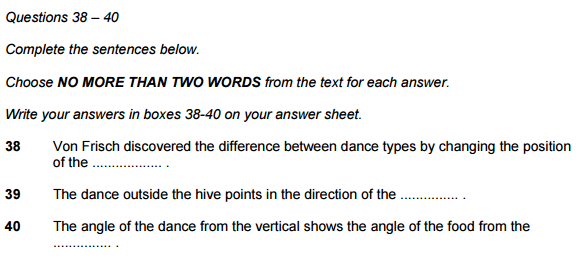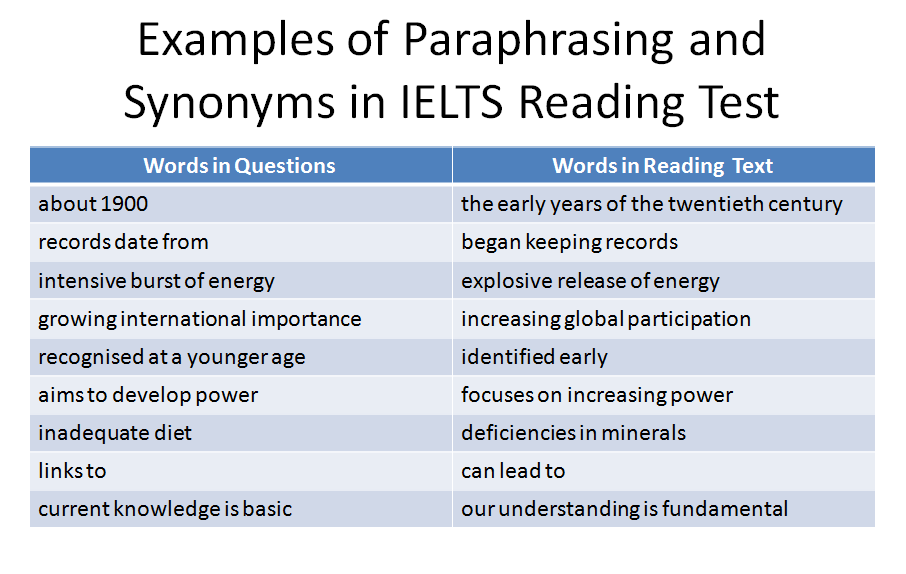In sentence completion question types, you will be given a number of sentences with gaps in them and asked to complete the sentences with words from the reading text.
These questions are as much vocabulary tests as they are reading tests because they require you to be aware of paraphrasing (using different words to repeat a sentence so that it has the same meaning) and synonyms (words with the same or very similar meanings). More on these below.
This post will:
- look at example sentence completion questions
- discuss paraphrasing and synonyms
- discuss common problems
- give you tips and advice
- provide you with a strategy to use on exam day
Example Question
Source: Cambridge English IELTS Past Papers.
As you can see there are three incomplete sentences that we must complete.
Note that it says NO MORE THAN TWO WORDS from the text for each answer. This means that we can write one or two words only. If we write any more than this, we get the question wrong.
Also, note that it says ‘from the text’. This means that we can’t change the words from the text.
The word limit and whether we should use words from the text or not can change from question to question so read them carefully.
To access more example reading questions for both the academic and general papers visit the ielts.org test sample page.
Paraphrasing and Synonyms
In order to do well on the IELTS reading test, you have to understand what paraphrasing and synonyms are because Cambridge use them so much in the reading and listening tests and expect you to use them in the writing and speaking tests.
Paraphrasing is simply rephrasing or saying the sentence again, so that it has the same meaning, but with different words.
Example–
Most men drive cars to work.
The majority of males use automobiles to get to their jobs.
As you can see, both sentences mean exactly the same thing but I have used different words.
I have used mostly synonyms to do this, i.e. words with the same or similar meanings.
Examples–
most – majority
drive – use
cars – automobiles
work – job
Why is this important?
We have to understand how Cambridge actually make the IELTS reading tests in order to be successful. The people who write the tests take a piece of writing and they then use paraphrasing and synonyms to make many of the questions. Therefore if you don’t understand this, it is like walking in the dark with no lights. Understand it and suddenly your world becomes brighter.
The table below shows just some examples from an IELTS reading paper. As you can see, paraphrasing and synonyms are used in many of the questions and if you were looking for words that exactly match those in the text you wouldn’t find them. Instead be aware that you are looking for meaning; not words.
Common Problems
As you have probably already guessed from the passage above, the main problem is students trying to match words in the question with exactly the same words in the reading text. Instead, you should be looking for words that mean the same thing i.e. paraphrases and synonyms.
Another common problem is not reading the instructions properly and then writing too many words or not writing the same words as in the reading text, as discussed above.
Finally, students often start reading the text before the question. This is confusing for most people and wastes time. Read the questions first.
Sentence Completion Tips
- Check how many words it asks you to write. If it says ‘no more than two’, you can write one or two words. If it says ‘no more than three’, you can write one, two or three words. Remember that numbers are written numerically, such as 72, count as one word and hyphenated words, such as state-of-the-art, count as one word.
- Sometimes the question will state ‘using words from the text’ or ‘from the text’. In this case, you should only use words from the text and not change them or use different forms of the words. If it does not say this, then you are allowed to change the words as long as the meaning is the same.
- The answers appear in the same order as the questions. The answer to number 1 will be above number 2, and the answer to number 3 will be below the answer to number 2.
- Remember that your answer should be grammatically correct. Check the type of word that fits in the space. Is it a verb, noun, adjective or adverb? This will help you answer the question correctly.
- When scanning for your answer, make sure you are thinking about paraphrasing and synonyms.
- Find where the answer is located in the text before you try to answer the question. Remember where before what.
- Read the questions before reading the text.
Sentence completion strategy
This is my suggested strategy. There are many different strategies and you should use the one you feel comfortable with. You can also adapt this strategy to what suits you.
- Read the instructions carefully, noting how many words you can write and if they want you to include the exact words from the question or not.
- Read the incomplete sentences first. Think about what word form can be used and try to predict the answer. Also, think about keywords and how they could be represented by synonyms or paraphrasing.
- Locate where the information is located by scanning quickly. If you can’t locate the answer quickly, move on.
- Read the incomplete sentence again.
- Study the reading text more carefully to establish the answer.
- Check your spelling.
- Repeat with the other sentences.





